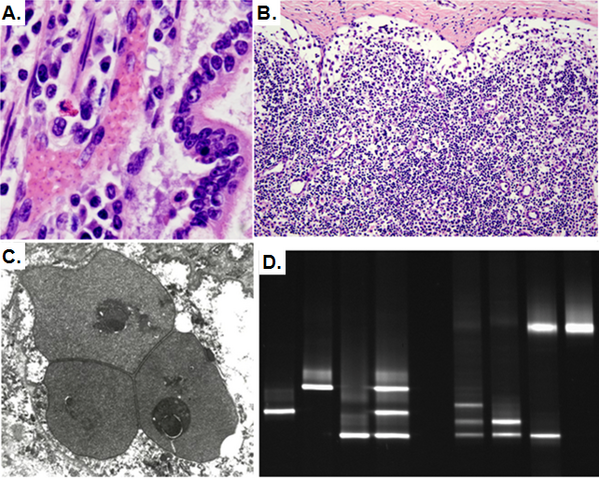A new study of African lions says climate extremes, which would include the increased frequency of droughts and floods predicted by global warming models, can create conditions in which diseases that are tolerated individually might converge and cause mass extinction of livestock or wildlife.
The study suggests that extreme climatic conditions are capable of altering normal host-pathogen relationships and causing a "perfect storm" of multiple infectious outbreaks that could trigger epidemics with catastrophic mortality.
Led by scientists at the University of California, Davis, the University of Illinois and the University of Minnesota, the research team examined outbreaks of canine distemper virus (CDV) in 1994 and 2001 that resulted in unusually high mortality of lions in Tanzania's Serengeti National Park and Ngorongoro Crater. CDV periodically strikes these ecosystems, and most epidemics have caused little or no harm to the lions.

A) Histopathology of Babesia hyperinfection in an adult lion that died during the epidemic. Small intestinal capillaries are occluded by parasitized red blood cells; B) Marked lymphocyte depletion in the lymph node of the same lion, indicating immunosuppression; C) Electron micrograph of intraerythrocytic piroplasms morphologically compatible with Babesia sp. in the deceased lion; D) Results of denaturant gradient gel electrophoresis for previously characterized carnivore hemoparasites and hemoparasites amplified by PCR from lion samples that demonstrated mixed infections. Lane 1, Babesia canis; lane 2, Cytauxzoon felis; lane 3, B. gibsoni; lane 4, mixture of B. canis, C. felis, and B. gibsoni isolates in lanes 1–3; lane 5, no DNA-negative control; lane 6, lion with Babesia sp. most similar genetically to B. gibsoni, B. felis and a previously uncharacterized Babesia sp.; lane 7, lion with Babesia sp. most similar genetically to B. gibsoni and B. felis; lane 8, lion with hemoparasites most similar genetically to B. gibsoni and Hepatozoon felis; lane 9, lion with a hemoparasite most similar genetically to H. felis. Source: 'Climate Extremes Promote Fatal Co-Infections during Canine Distemper Epidemics in African Lions.' PLoS ONE
But the fatal virus outbreaks of 1994 and 2001 were both preceded by extreme drought conditions that led to debilitated populations of Cape buffalo, a major prey species of lions. The buffalo suffered heavy tick infestations and became even more common in the lions' diet, resulting in unusually high levels of tick-borne blood parasites in the lions. (These parasites are normally present in lions at harmlessly low levels.)
The canine distemper virus suppressed the lions' immunity, which allowed the elevated levels of blood parasites to reach fatally high levels, leading to mass die-offs of lions. In 1994 the number of lions in the Serengeti study area dropped by over 35 percent after the double infection. Similar losses occurred in the Crater die-off in 2001.
The lion populations recovered within 3-4 years after each event, but most climate change models predict increasing frequency of droughts in East Africa.
"The study illustrates how ecological factors can produce unprecedented mortality events and suggests that co-infections may lie at the heart of many of the most serious die-offs in nature," said Packer, Distinguished McKnight University Professor of Ecology, Evolution and Behavior at the University of Minnesota.
The study was funded by the National Science Foundation and the Morris Animal Foundation.
Citation: Munson L, Terio KA, Kock R, Mlengeya T, Roelke ME, et al. (2008) Climate Extremes Promote Fatal Co-Infections during Canine Distemper Epidemics in African Lions. PLoS ONE 3(6): e2545. doi:10.1371/journal.pone.0002545




Comments